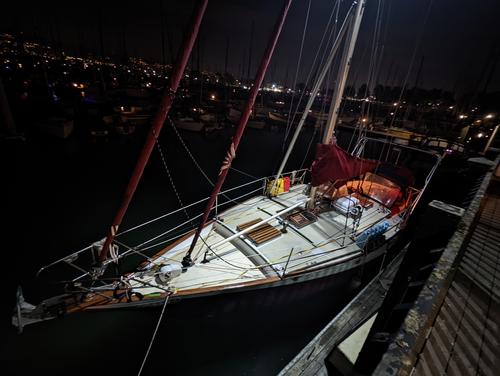
So, What Happened?
The “Plan”
People don’t really change, but plans do.
The forecast for departure, even ten days prior showed some unfavorable conditions for a trip down South from San Francisco to Ventura, such as strong Southerlies (winds blowing from South to North) and rain. I’m not the sort of sailor that is interested in fighting for every possible measure of progress against the wind, tacking back and forth between five and 20 miles offshore. The forecast models all continued to agree and the day before I was scheduled to leave, I begrudgingly submitted and decided it was necessary to delay the departure.
For those that know me, they know I am obsessed with time. In a job interview, when they ask that silly question about your biggest weakness, “impatience” is always the play. It kills me inside any time I will be anything but early. The date to leave was pretty arbitrary, but it was still an exercise in patience to say, “There’s nothing I can do about this.” Anyway, two days after the “scheduled” departure of 26 March, there was what appeared to be a more favorable weather window staring at me — five days of Northerlies (winds blowing from North to South), albeit they were pretty strong in the forecasts at 16 knots average speed and gusting to a MAXIMUM of 22… it actually sounded kinda nice.
Well, it wasn’t.
Departure
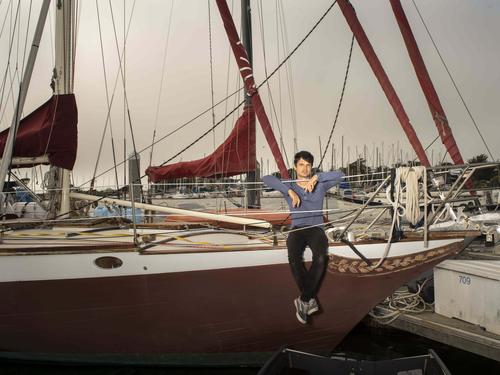
The Bon Voyage event was well-attended by those that have been close to me in the past year. The previous blog post I wrote came in very handy, answering the majority of questions I usually get. At the party, I explained to some of the seasoned pros that I was delaying departure because of weather and I always got a knowing nod from them and some version of “good idea” escaping their lips immediately afterwards. It’s often said that “A sailor’s plans are written in sand.” I didn’t really consider myself a “sailor” just yet, though.
Leading up to leaving, I had really burned myself out with both my job and the number of boat projects I had to do. These extra two days would give me the excuse I needed to rest up. So, for two days, the crew and I just meandered around Berkeley and took life at a leisurely pace. Monday, 28 March at 0800 was the new time to leave. The boat was ready.
Monday
The crew awoke at 0700 and felt pretty optimistic. My heart was racing a little bit, because when you tell a bunch of people you’re departing to go around the world, you feel a bit of pressure to actually do it. Perhaps I got a small taste of what Donald Crowhurst must have felt before leaving on his ill-fated Golden Globe race departure.
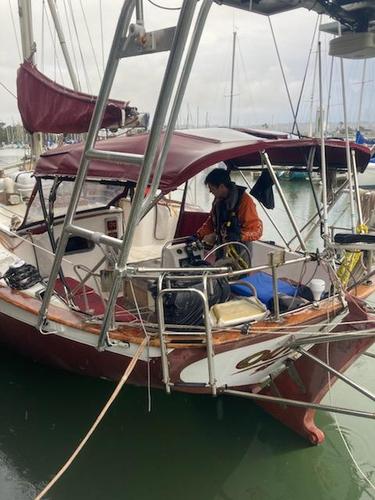
A few people that are important to me showed up and got some photos and video of my leaving, as well as providing some emotional goodbye well-wishes. We left the dock at 0815, delayed by a halyard snagged around my [broken] steaming light above the spreaders on my mast, which required me to climb up real quick.
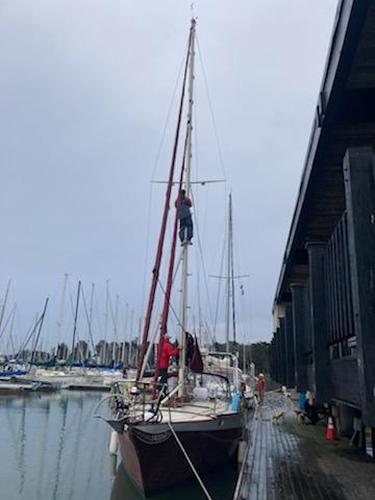
The tide schedule hinted that by the time we’d reach The Golden Gate Bridge, we would ride an ebbing current out, without any headwind. We ended up motoring for around three hours until The Big Left turn, just outside the last red buoy of the shipping channel leading to the SF Bay.
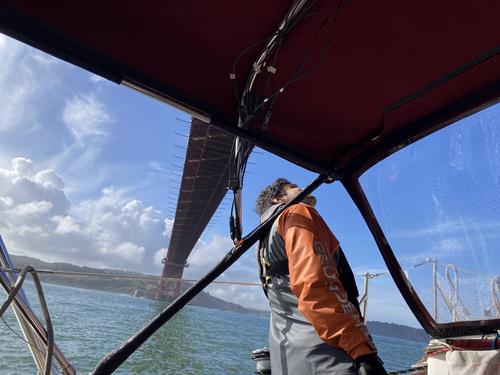
At this point, we had eight knots of true wind from the North/Northwest and very small seas (waves). We raised the sails and made the turn, getting around 1.7 knots SOG (Speed Over Ground, measured with GPS, as opposed to through the water, measured with a “knotmeter” paddle wheel), increasing to more than 3 knots SOG soon thereafter. We were ecstatic to have such impressive speed with a heavy boat like mine, especially considering my lack of a light-wind sail plan.
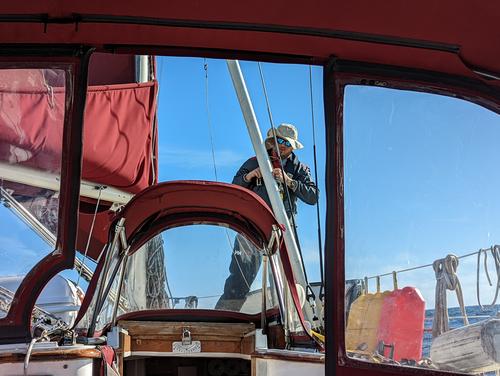
After a few hours of sailing, I witnessed an enormous humpback breach the surface ten feet off the port bow, perhaps to wish me luck on the journey, or maybe the opposite. It dove below the surface, waving farewell with its powerful tail before disappearing into nothing, leaving the crew alone.
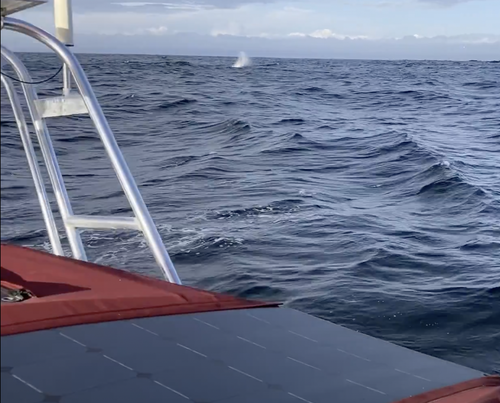
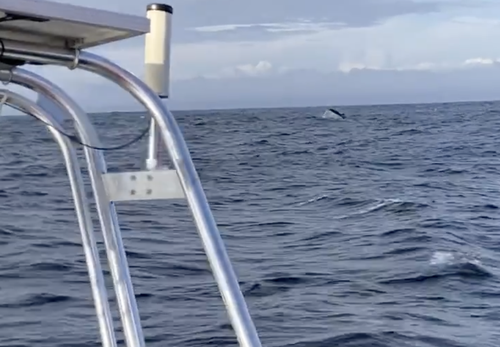
We passed Half Moon Bay in clear daylight with about 8 knots from the West at 4.5 knots SOG.
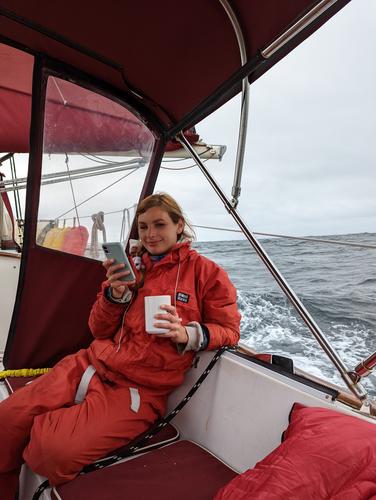
Things were still good when nightfall came, so we decided to leave the sails up in a DDW (dead downwind) wing-on-wing configuration, which was perfectly stable for us, pushing us along at almost 7 knots SOG on average, with added speed boosts as we surfed down the waves. The Monitor Windvane and its attached Pelagic autopilot were driving us exactly on course, able to correct if a gust or a swell rotated us a bit.

We went by Monterey Bay in the middle of the night at our maximum distance of 25nm offshore with 17 knots from NorthWest at 6 knots SOG. The seas were starting to increase in size, from three-to-six feet, to six-to-ten. We saw bioluminescent plankton in clear trails behind the boat and a clear sky above, with more stars than I had ever seen in my entire life.
Tuesday
Just after dawn, things started to feel different. The wind very quickly increased to 25 to 30 knots. Just before it got that high, we decided to reef (make the sails smaller). We had the whisker pole up for dead downwind sailing, and we figured out that it’s really difficult to take down in any waves at all. We therefore just left it up, attached to the furled up jib’s port side sheet, nice and tight against the forestay.
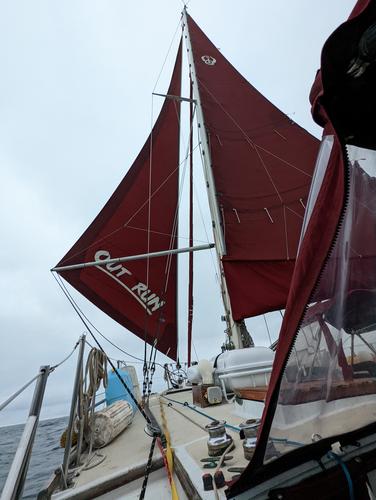
The mainsail had a preventer line attached to it to stop an accidental jibe from happening if a wave threw our heading off. We loosened up the preventer line as we headed into the wind, where dropping the main down would be much easier. I went on deck to attempt to lower the mainsail. At this point, it’s important to say that I’ve done this procedure plenty of times and am already well-practiced at it, but offshore, things are just different. I was jacklined in as I went on deck. Another crew member did their best to steer into the wind, but we didn’t have enough momentum the boat kept trying to stay at a beam reach. This is when I made my first major mistake of the trip.
Crew asked if we should turn on our engine to help steer into the wind and I shouted (not out of anger; it’s just really loud up there) “No!” Right after that, in about 25 knots of wind and increasing swell (made more apparent by our new relative direction to the waves while reefing), I tried to force the mainsail down and didn’t realize at the time that the halyard was fouled (caught) on my mast-mounted winch, which had suddenly come apart due to a snapring failure. The winch was now inoperable and it’s what’s holding all of the tension of the main. After failing to reef for a while, I turned on the engine and had a crew member steer us into the wind, where I was able to unfoul the main halyard and bring the mainsail down to a double reef. There is no third reef in my main, as I had planned on buying a storm trysail at some later date.
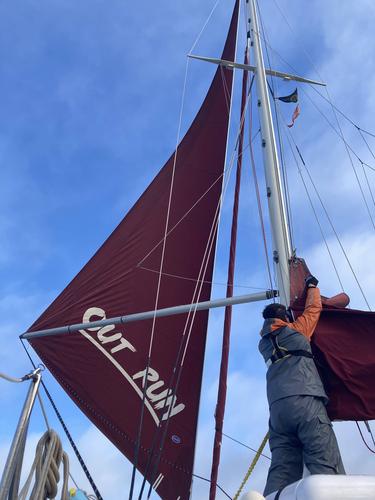
With that pole up, we decided to continue downwind under just the mainsail sheeted out as far was it could go. That was another mistake. Thankfully, I had cell service most of the time, thanks to my LTE to WiFi box I had made. I was able to get in contact with some ground support that agreed to help if I got in a pinch.
SF Bay sailing involves lots of wind most of the time, but paradoxically, it feels like it’s always upwind, both when you depart and when you come back to home port. I started to realize I’m not as familiar with sail trim while going downwind in heavy weather as I thought I was.
I knew that with the main out, it would cause a ton of weatherhelm (the tendency for a boat to try to “come up” into the wind), so I got a hot tip that taking the pole down would be a worthwhile venture. The crew agreed and at some point on Tuesday, we brought the main down all the way, got the pole down, which it turns out wasn’t so bad to do without the mainsail up, and continued with just a “hankerchief” (heavily reefed) jib. In our consistent 25 knots from the north, we started seeing average speeds closer to 5 knots SOG.
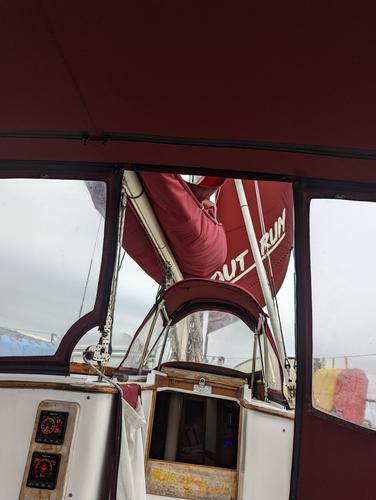
When I left the dock, my knotmeter wasn’t functioning, which I wasn’t so worried about considering I had redundant GPS devices onboard to guage speed with, but it’s always nice to have it working because it’s able to give better inference of true wind direction when tied to my NMEA 2000 data network. But after a few days of moving fast and getting knocked around, it must have cleared up whatever blockage was stopping the paddle from turning and we were suddenly able to see our speed through this clear blue ocean water.
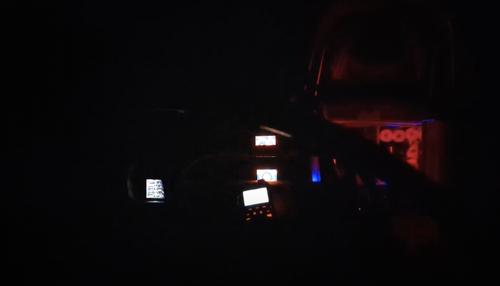
We continued to hand-steer throughout the day and the night was more of the same — just hard-charging on our course. At night, you can’t see too much, and you definitely can’t use land a reference point, so all we had to go off for our heading was our instruments, glowing red against the never-ending blackness. If the heading number got too low, we turn to starboard, if it got too high, turn to port. Repeat as needed.
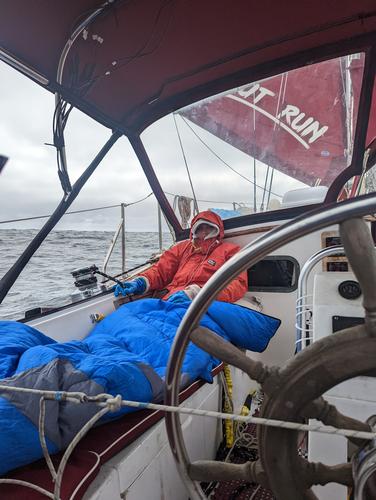
PredictWind showed us arriving in Ventura by no later than 8am on all predicted weather model routes on Wednesday. ‘Looks like I need to update my boat’s “polar” model (the graphed out boat speed with a given amount of wind). There was no way we’d arrive in time. The sleep deprivation and aggravated nature of close-quartered hellscapes led to my next mistake.
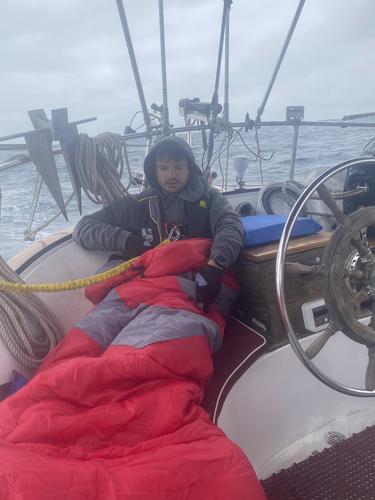
In the middle of the night, it was decided that we do a little jibe in order to start heading a bit more inland, where the wind was supposed to be less-intense. We only had a jib out, but we made a mistake by not pulling the jib out enough to one side while letting out slack on the opposing lazy sheet. This caused the jib to start flailing wildly. When jib sheets do that, it gets dangerous. There’re a lot of forces acting on those lines. And while the sheets were flapping, I noticed a fouling where the were caught on deck, so I jacklined in and went on deck, cleared the tangle, and then a wave hit us in the darkness. I lost my balance and fell backwards over my lifelines, such that my head was facing downward at the rushing ocean, but I had caught myself and arrested any chance of a fall. I recovered and made my way back to the cockpit.
My crew member yelled at me for doing something so stupid. I’ll die on the hill that they didn’t see everything that happened while I was on deck, but a lesson was hard-learned to move more slowly on deck in any swell.
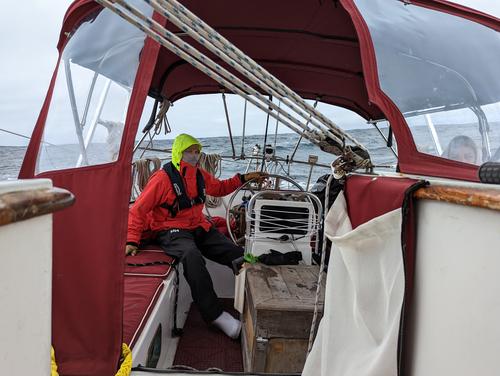
Wednesday
The winds refused to let up. After Ragged Point, we were seeing 25 to 30 knots of true wind, consistently. It just refused to let up. Now, one may be wondering, “Why didn’t they just go to their nearest safe harbor?” We were decently far offshore and let’s say the next safe place to anchor (which we had all of them for the coast mapped out) was 20 nautical miles away. With our average speed of around 5 knots SOG, it would take four hours to get there. And once we’re there, then what? The forecast showed the winds only increasing from that point in time, so the following days would be even more windy than if we just finished the task at hand.
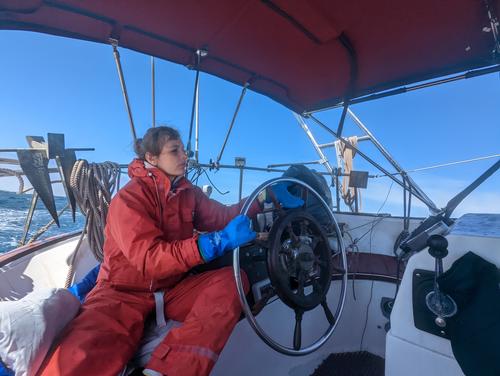
We already had too much wind, but we were starting to learn how to tame it with these waves. I learned an important lesson — when the autopilot works, optimism shines through. When it doesn’t, things are too crazy to be comfortable and another side of me starts to come out. It’s one that I’m not so acquainted with.
This isn’t fun, anymore.
Leading up the the trip’s crescendo, Point Conception, I started to doubt myself and my ability to do all of this. I started asking myself “why” I’m bothering to try sailing around the world. What was I trying to prove. I still don’t know the answer, but I mentioned this to some friends and one of them told me something that inspired me almost to the point of bringing an empathetic tear of reprieve to my eye:
You’re out there wondering why you’re doing this and I’m wondering why I’m not.
It occurred to me that this is literally the dream. It’s what people around the world say they will do, and here I am, actually doing it. Things just felt so difficult when I was relentlessly getting slapped by heavy seas and I realized that even though I’ve over-prepared for the past five years, I, practically speaking, have absolutely no idea what I am doing.
But, the interesting thing is, even though I feel incompetent, somehow, the boat is still floating and we’re going in exactly the right direction. And oh, wait? Our speed is actually incredibly fast??? And, hold on a second, the only thing that broke so far was a winch?

Okay. We can actually pull this off. Let’s go.
Right after I realized this, the whole game changed. The sun came out and dolphins started following us. The wind kept increasing — 30, 32, 35 knots from the NorthWest. Point Conception approaches.

Referred to in the official pilot charts of California as “The Cape Horn of California,” the unique geography of this part of the state, combined with prevailing wind patterns from the North/NorthWest create a sort of funnel for airflow that force it to speed up before falling off precipitously. I was warned about this trip, but the forecasts all showed consistent weather patterns even past this point. I considered the warnings I was given and while the go/no-go decision was “go” for Point Conception on schedule, we did give it a five nautical mile separation zone from the boat and the shore, because apparently, the closer you get to Point Conception proper, the less predictable things can get, and as the water gets more shallow, the seas become bigger.
Our approach continued, and I noticed something about my boat and how it handles various wind speeds:
| Wind Speed | Severity |
|---|---|
| 0 to 5 knots | Dead Calm |
| 6 to 12 knots | Light |
| 13 to 20 knots | Ideal |
| 21 to 22 knots | Brisk |
| 23 to 30 knots | Heavy |
| 31 knots and up | Heavy |
There’s no perceivable difference when trying to steer in 23 knots versus 35 knots downwind on my boat.

So, even though Point Conception was increasing our windspeed by a bit, we started to feel more confident about getting through this. About two hours past The Point, the winds started to ease. By the time we approached the second offshore oil rig, we started to notice an unfamiliar feeling after bring in the SF Bay for so long, warmth. As sunset began, we realized we were in paradise. Still making good speed in our lighter winds, we had passed Santa Barbara as the light went away. Just before it did, I remember looking off to port and seeing the California coast line, using it as confirmation that I’m not crazy and that we’re going the right way. But at some point, I looked off to starboard and saw an equal land mass and got confused. “Huh?” It was the Channel Islands, which are much larger than they appear to be on maps. There’s sort of a mirage that they all converge into a single piece of land.
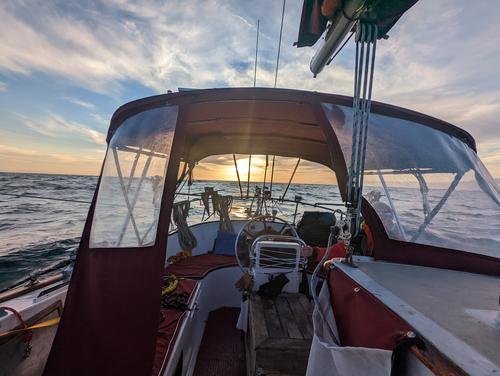
As night fell, so did the winds. The seas were calming, as well. We were still about 17nm from Ventura’s marina village when the windspeed dropped to almost nothing and we made the decision to fire up the engine and motor into Safe Harbor. We called ahead during business hours and notified them of our expected arrival time of perhaps 1 or 2 in the morning. The marina’s advice was to have harbor patrol escort us to our slip.
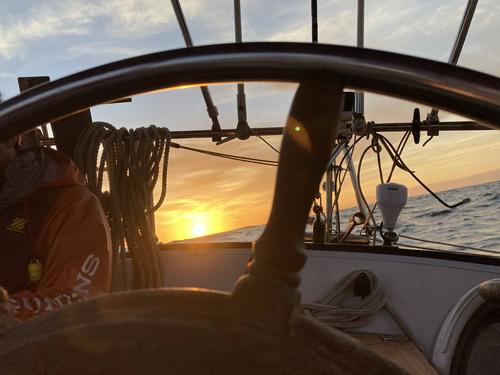
Thursday
When we were right outside of the charted channel and only navigation lights were visible, we called up the patrol service and they met us right outside the channel, signaling us with their blue police lights and communicating via VHF. We followed them in through the marina’s labyrinth and they led us right to our slip, which I was able to maneuver into and dock without issue.
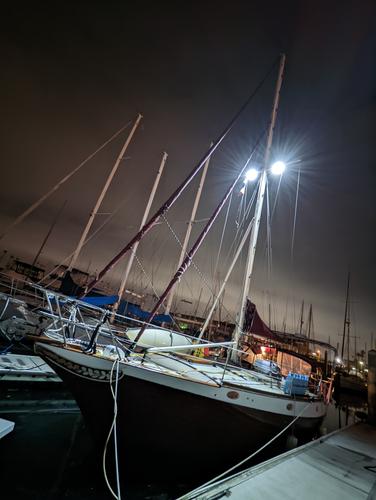
And just like that, at 2am, we were done with the boat part of the journey. It was definitely time for showers on land.
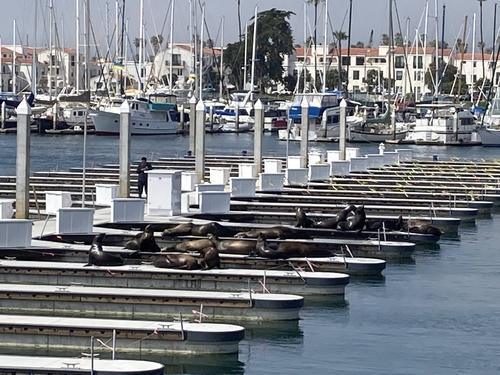
In the morning, I was able to assess the boat and what may have went wrong on the way. The list of things that broke is as follows:
| Item | Cost |
|---|---|
| Missing snap ring on mainsail winch on mast, making winch ineffective | $5 |
| Sheared through-bolt on starboard stanchion (may have already been broken) | $3 |
| Dickinson Newport stainless diesel fireplace stovetop above-deck (already partially broken on departure) | $150 |
That’s it. Nothing else is damaged. Really, not bad. Things could have gone way worse and maybe they should have, but they didn’t. The crew stuck together and we made it.
Epilogue
The heavy winds seem to be predominantly be behind me (on average), and I have an order for new lightwind sails to arrive soon:
- 135% Genoa
- Asymmetric furling spinnaker
After explaining the trip to many other cruisers, I was told a few times that this leg is likely one of the most difficult I’ll embark on given the nature of the North American Pacific coast North of Point Conception. More than one cruiser called me insane for making my first departure such a difficult one.
Before departing on the trip, I had arranged to have some celebration on arrival in the LA area. On Friday, we left the boat to hang out in Anaheim for the weekend. We hit up Disney’s California Adventures, Disneyland, Knott’s Berry Farm, and Medieval Times all in one weekend. It was a good way to decompress and it juxtaposed our more sedentary lifestyle over the course of the sail by taking more than 40,000 steps across three theme parks.
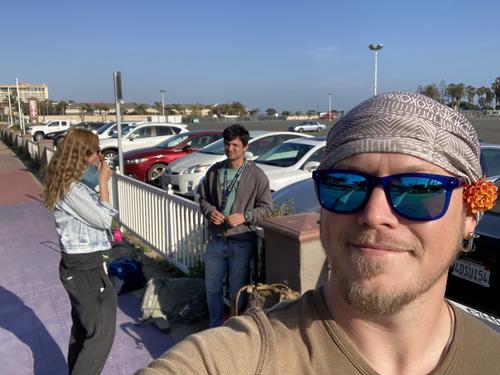


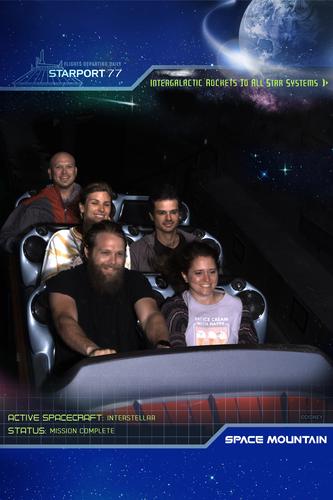

I’m very grateful to have made it so far, even though I’ve only just begun. The experience hasn’t really changed me; I’m just a bit better than I was before I left. The plan is shifting a little bit, but everything is still within the margin of error.

There have already been people trying to discourage me from my itinerary. They are failing, but I will not.
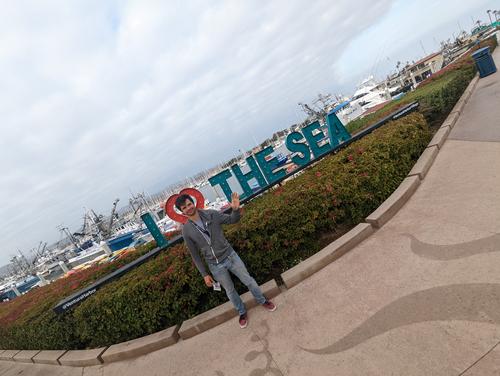
Previous: What's the Plan for Departure? | Next: Mast Work and Synthetic Rigging
- [ 2024-09-01 ] Don't do It
- [ 2021-04-25 ] Replacing Chainplates
- [ 2021-02-19 ] Three Months of Hell in Napa
- [ 2021-02-02 ] Wireless Networking on a Sailboat
- [ 2020-10-21 ] Installing a New Electric Anchor System
- [ 2020-08-02 ] Making Custom Cockpit Cushions
- [ 2020-08-02 ] Setting Up A Signal K Server with a USB Gateway